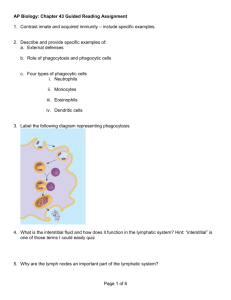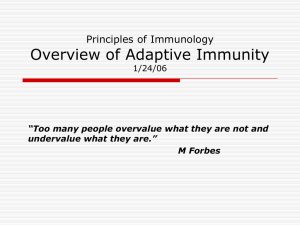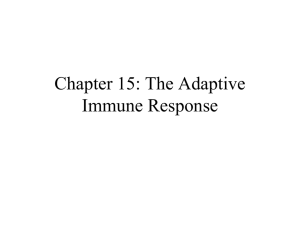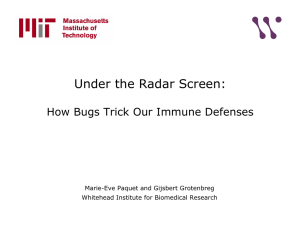Innate Immunity & Antigen Presentation: Immunology Overview
advertisement
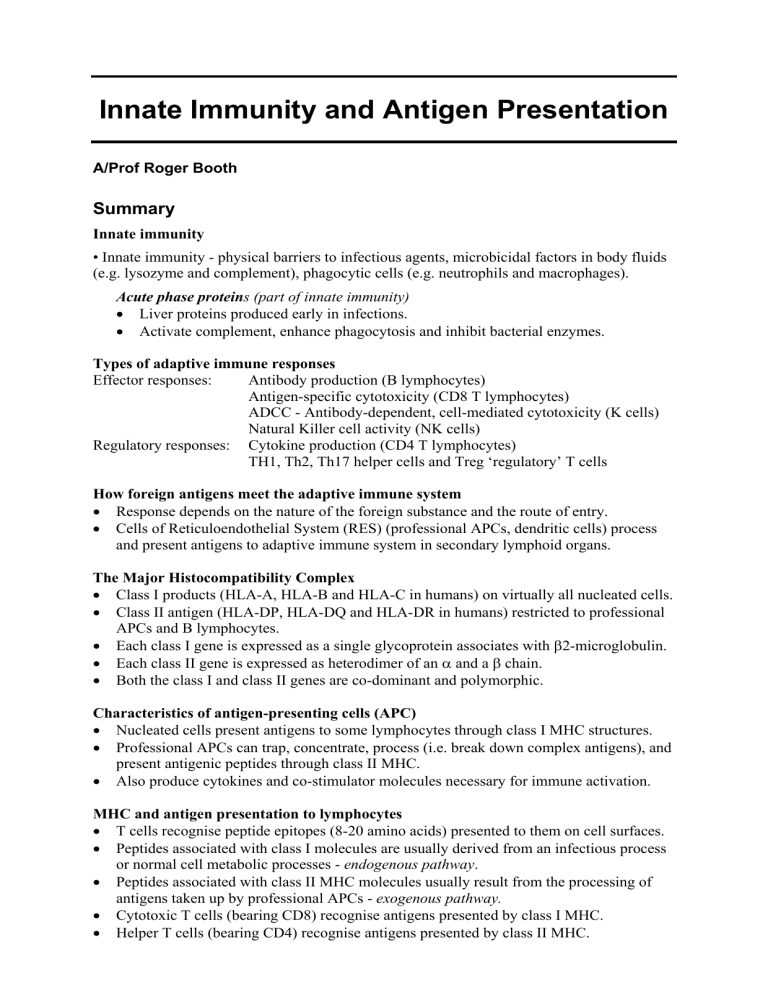
Innate Immunity and Antigen Presentation A/Prof Roger Booth Summary Innate immunity • Innate immunity - physical barriers to infectious agents, microbicidal factors in body fluids (e.g. lysozyme and complement), phagocytic cells (e.g. neutrophils and macrophages). Acute phase proteins (part of innate immunity) • Liver proteins produced early in infections. • Activate complement, enhance phagocytosis and inhibit bacterial enzymes. Types of adaptive immune responses Effector responses: Antibody production (B lymphocytes) Antigen-specific cytotoxicity (CD8 T lymphocytes) ADCC - Antibody-dependent, cell-mediated cytotoxicity (K cells) Natural Killer cell activity (NK cells) Regulatory responses: Cytokine production (CD4 T lymphocytes) TH1, Th2, Th17 helper cells and Treg ‘regulatory’ T cells How foreign antigens meet the adaptive immune system • Response depends on the nature of the foreign substance and the route of entry. • Cells of Reticuloendothelial System (RES) (professional APCs, dendritic cells) process and present antigens to adaptive immune system in secondary lymphoid organs. The Major Histocompatibility Complex • Class I products (HLA-A, HLA-B and HLA-C in humans) on virtually all nucleated cells. • Class II antigen (HLA-DP, HLA-DQ and HLA-DR in humans) restricted to professional APCs and B lymphocytes. • Each class I gene is expressed as a single glycoprotein associates with β2-microglobulin. • Each class II gene is expressed as heterodimer of an α and a β chain. • Both the class I and class II genes are co-dominant and polymorphic. Characteristics of antigen-presenting cells (APC) • Nucleated cells present antigens to some lymphocytes through class I MHC structures. • Professional APCs can trap, concentrate, process (i.e. break down complex antigens), and present antigenic peptides through class II MHC. • Also produce cytokines and co-stimulator molecules necessary for immune activation. MHC and antigen presentation to lymphocytes • T cells recognise peptide epitopes (8-20 amino acids) presented to them on cell surfaces. • Peptides associated with class I molecules are usually derived from an infectious process or normal cell metabolic processes - endogenous pathway. • Peptides associated with class II MHC molecules usually result from the processing of antigens taken up by professional APCs - exogenous pathway. • Cytotoxic T cells (bearing CD8) recognise antigens presented by class I MHC. • Helper T cells (bearing CD4) recognise antigens presented by class II MHC. What Determines Whether We Get Infections Exposure to infectious organisms doesn’t necessarily result in infection. • Initial barriers to infection often referred to as innate immune mechanisms. • Beyond these are adaptive immune mechanisms (e.g.antibodies and cytotoxic T cells). • Innate and adaptive mechanisms do not act independently of each other nor of other activities such as factors from our neuroendocrine and autonomic nervous system. In turn, the brain and neuroendocrine systems are affects by immune system activity. The Innate Immune System Neutrophils and Innate Immunity Phagocytosis promoted by: • Common bacterial cell wall components (weak interaction) • C3b complement component (complement-mediated opsonisation) • Fc region of antibodies (immune complex-mediated opsonisation) Innate Immune Recognition Pathogen-Associated Molecular Patterns (PAMPS) recognized by Pattern-Recognition Receptors (PRRs) • • Common cell wall structures: - Lipopolysaccharides (LPS) - Peptidoglycans (e.g. mannans and mannoproteins) Bacterial metabolic products: - • N-formylmethionine peptides (e.g. f-Met-Leu-Phe) Heat-shock proteins: - Conserved chaperone molecules expressed by prokaryotes and eukaryotes => Lead to danger signals Acute Phase Proteins • Plasma proteins produced early in infections in response to early alarm mediators such as macrophage-derived interleukin-1 released following tissue injury. • Many produced in the liver. • Act to: - Enhance host resistance - Minimize tissue injury - Promote resolution and repair of inflammatory lesions Cells of the Adaptive Immune System Effectors: Regulators: Cell type Total T cells T cell subsets T cell activation B cells NK/ADCC cells B Antibody production (CD20) CTL T cell-mediated cytotoxicity (CD8) (Cytotoxic or killer cells) NK/K Natural killer cells (Early defence in anti-viral and tumour immunity) Antibody-dependent cell-mediated cytotoxicity (ADCC) (CD16, CD56) TH/Treg Control of effector responses (CD4) Helper or inducer cells Recruitment of non-specific mechanisms TH1 (viruses, bacteria), TH2 (parasites, allergies), TH17 (mucosal surfaces and inflammatory processes), Treg (regulatory T cells - down-regulation) Cell-surface marker CD3 CD4 CD8 CD3/HLA-DR CD3/CD25(IL-2R) CD19 or CD20 CD16 or CD56or CD57 Percent of lymphocytes 75 45 30 7 5 12 12 Number of lymphocytes (/ ul) 1500 900 600 150 100 250 250 Circulation of Lymphocytes Around 10% of lymphocytes are circulating at any time. Lymphocytes can migrate out of the blood system into tissues through specialized area of capillaries called high endothelial venules (HEV). Recirculating lymphocytes pass from the blood through the lymphoid system and back to the blood, percolating through the lymphoid organs where they may contact processed antigens. Not all classes of lymphocyte recirculate to the same extent, and various cell-surface and intercellular signals influence the flow of lymphoid cellular traffic. Long-lived lymphocytes, most of which are T cells and memory cells, are the most mobile. How Foreign Antigens Meet the Adaptive Immune System • Response depends on the nature of the foreign substance and the route of entry. • Lymph nodes (tissue antigens) • Spleen (blood-borne antigens) • GALT - gut-associated lymphoid tissue (tonsils, adenoids, peyer’s patches, appendix) (mucosal antigens) • Non-infectious material will almost certainly be treated differently from infectious agents. • Infectious organisms such as viruses, that replicate inside host cells, will be treated differently from organisms such as extracellular bacteria and parasites. Transport antigens to secondary lymphoid organs and presentation of antigenic fragments to lymphocytes there. Often referred to as specialised or professional antigen-presenting cells (APC). Skin: Lungs: Blood: Liver: Gut: Langerhans cells Alveolar macrophages Blood monocytes, Kupffer cells Epithelial M cells Lymphatic transport to regional nodes Transport to spleen or regional nodes Transport to spleen Transport to spleen or regional nodes Transport to Peyer’s patches (Janeway and Travers, Fig. 7.15, p7:13 (adapted)) Functions of Specialised Antigen-Presenting Cells (APC) • • • • • • Antigen collection Antigen concentration Antigen processing Antigen presentation to lymphocytes Co-stimulation - cytokines (e.g. pro-inflammatory cytokines IL-1, IL-6, TNF-α) - co-stimulator accessory surface molecules Tolerance induction Events in a Lymph Node following Antigen Entry (Janeway and Travers, Fig. 5.19, p5:23) 1. Antigen enters the lymph node through afferent lymphatics, often carried by professional APCs, and small naive lymphocytes enter from the bloodstream. 2. T cells migrate to T cell (paracortical) areas and B cells migrate to the follicles. 3. Lymphocytes that recognize the antigen stop recirculating and are activated. Lymphocytes that do not recognize antigen leave via the efferent lymphatic vessel. 4. After several days, activated lymphocytes leave the efferent lymphatic vessel as effectors. Pathways of Antigen Processing Antigens are processed by cells and peptide fragments of them are expressed on the cell surface by specialized molecules called Major Histocompatibility Complex (MHC) molecules (called HLA in humans). Antigens processing differs according to whether the antigens are ingested by the cell or whether they originate from within the cell. The endogenous pathway: (Janeway and Travers, Fig. 4.12, p4:14) Antigenic peptides that associate with class I MHC molecules are usually derived from an infectious process (such as virus infection and replication) or as a result or normal breakdown of normal cell metabolic products within the cell. A. Cytosolic proteins are degraded into peptide fragments by proteosomes which are large, multicatalytic proteases. B. Peptides produced are inaccessible to the class I MHC molecules which remains bound to the TAP-1 transporter complex on the endoplasmic reticulum (ER). C. Peptides are transported into the lumen of the ER by the TAP transporter and are ‘inspected’ by the TAP-bound class I MHC. D. When a peptide binds to class I MHC tightly, the MHC molecule folds around the peptide and is released from TAP-1 to be transported to the cell membrane. The exogenous pathway: Peptides that associate with class II MHC molecules usually result from the processing of antigens which have been taken up and degraded by professional antigen-presenting cells using phagocytic or pinocytic mechanisms. (Janeway and Travers, Fig. 4.13, p4:15) A. Antigen is taken up from outside the antigen-presenting cell into intracellular vesicles. B. Acidification of vesicles activates proteases to degrade antigen into peptide fragments. C. Vesicles containing peptide fragments fuse with vesicles containing class II MHC and peptides with affinity for antigen-binding groove of class II MHC bind to it. D. Bound peptide is transported by class II MHC to the cell surface. • Not all peptide fragments resulting from antigen processing will be immunogenic epitopes. Only those with affinity for the peptide-binding groove will be capable of being presented to lymphocytes. • Because of differences HLA molecules among people, not everyone will necessarily present the same epitopes to the immune system. Thus, the nature of a person's response to an antigen is dependent on the HLA genes that he or she has. • Because Class I HLA products are expressed on virtually all nucleated cells in the body, most cells can present peptide fragments derived from metabolic breakdown or from intracellular infectious processes. • Because Class II HLA products are expressed only on B cells and professional APCs, only these cell types can present peptide fragments of ingested material. Antigen Presentation to T Lymphocytes T lymphocytes only recognise peptide antigens presented to them by MHC cell-surface structures. • Cytotoxic T cells only recognise antigens presented by class I MHC. • Helper T cells only recognise antigens presented by class II MHC. T cells have T Cell Receptor for antigen (TCRαβ) through which they bind to presented peptides and accessory glycoproteins (CD4 and CD8) assist the process. • TCRαβ is a heterodimer with variable and constant domain similarities to immunoglobulin heavy and light chains. • CD8 on cytotoxic T cells binds to non-polymorphic regions of class I MHC. • CD4 on helper T cells binds to non-polymorphic regions of class II MHC. • The CD3 complex on the surface of all T cells transduces the antigen binding event into an activation signal within the cell. Further Reading Delves PJ, Martin SJ, Burton DR, Roitt IM. 2011. Roitt's Essential Immunology, 12th Edition, Wiley-Blackwell. Chapters 1 and 5. Janeway CA, Travers P, Walport M, Shlomchik MJ. 2001. Immunobiology. 5th Edition, Garland Science, New York.


